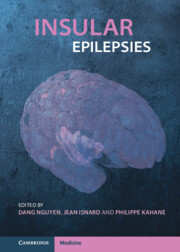Book contents
- Insular Epilepsies
- Insular Epilepsies
- Copyright page
- Contents
- Contributors
- Foreword
- Chapter 1 A Brief History of Insular Cortex Epilepsy
- Section 1 The Human Insula from an Epileptological Standpoint
- Section 2 The Spectrum of Epilepsies Involving the Insula
- Section 3 Noninvasive Investigation of Insular Epilepsy
- Section 4 Invasive Investigation of Insular Epilepsy
- Section 5 Surgical Management of Insular Epilepsy
- Chapter 22 Insular Epilepsy Surgery: Surgical Techniques and Experience of Various Centers
- Chapter 23 Stereoelectroencephalography (SEEG)–Guided Radiofrequency Thermocoagulation (RFTC) of Insular Epileptic Foci
- Chapter 24 Neurostimulation for the Treatment of Insular Epilepsy
- Chapter 25 Laser Interstitial Thermal Therapy (LITT) for Insular Epilepsy
- Epilogue
- Index
- References
Chapter 23 - Stereoelectroencephalography (SEEG)–Guided Radiofrequency Thermocoagulation (RFTC) of Insular Epileptic Foci
from Section 5 - Surgical Management of Insular Epilepsy
Published online by Cambridge University Press: 09 June 2022
- Insular Epilepsies
- Insular Epilepsies
- Copyright page
- Contents
- Contributors
- Foreword
- Chapter 1 A Brief History of Insular Cortex Epilepsy
- Section 1 The Human Insula from an Epileptological Standpoint
- Section 2 The Spectrum of Epilepsies Involving the Insula
- Section 3 Noninvasive Investigation of Insular Epilepsy
- Section 4 Invasive Investigation of Insular Epilepsy
- Section 5 Surgical Management of Insular Epilepsy
- Chapter 22 Insular Epilepsy Surgery: Surgical Techniques and Experience of Various Centers
- Chapter 23 Stereoelectroencephalography (SEEG)–Guided Radiofrequency Thermocoagulation (RFTC) of Insular Epileptic Foci
- Chapter 24 Neurostimulation for the Treatment of Insular Epilepsy
- Chapter 25 Laser Interstitial Thermal Therapy (LITT) for Insular Epilepsy
- Epilogue
- Index
- References
Summary
We report, in a cohort of 16 patients presenting with epilepsy arising from the insulo-opercular cortex solely, the outcome following SEEG-guided radiofrequency thermocoagulation (RFTC). Good outcomes (Engel class 1) are reported in 88% at 2 months and 67% at 18 months among the 9 of the 16 cases who had electrodes implanted following parasagittal trajectories. No one had an Engel class 1 outcome at 1 year in the group of 7 patients who had electrodes inserted solely orthogonally. No complications occurred. The benefit-risk ratio of the SEEG-guided RFTC procedure proved to be particularly favorable for patients presenting an epileptogenic focus located in the insula or in the medial aspect of the operculum, especially when using parasagittally, rather than orthogonally, implanted electrodes to coagulate. Therefore, this technique could be used, in selected cases, as the first-line therapeutic option procedure related to insular epilepsy, providing, in many cases, complete control over epileptic disease.
- Type
- Chapter
- Information
- Insular Epilepsies , pp. 266 - 277Publisher: Cambridge University PressPrint publication year: 2022

